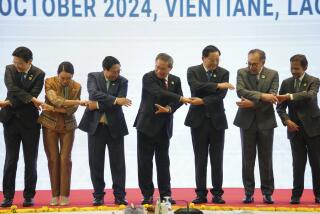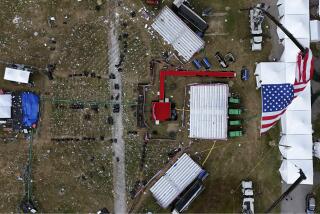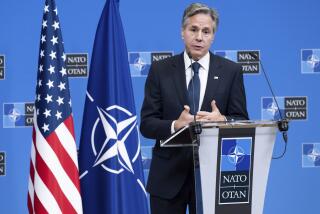CHINA: THE GIANT AWAKENS : Military : Wary Neighbors Watch China Arm : Asians wonder about Beijing’s strategic intentions. Some fear instability if it seeks to convert growing economic clout into political hegemony.
TOKYO ‚ÄĒ Is the wave of the future in Asia a Chinese military colossus? A Japan so overwhelmed by its populous neighbor that it would be a tool in China‚Äôs hands?
These are questions that Asians are beginning to ponder as China moves toward a new status as an economic superpower. And the possible answers pose dramatically opposing alternatives for Asia’s future.
A China concentrating on economic development would continue to provide, as it already has, a significant spur to Asian growth. But a China intent on flexing its muscles could destabilize the entire region, spurring an unproductive arms race. Indeed, a ‚Äúmini-race‚ÄĚ already has started.
So great is China‚Äôs economic surge that leaders like Singapore Prime Minister Goh Chok Tong are now predicting that China could overtake the United States as the world‚Äôs largest economy in 20 to 30 years. ‚ÄúChina‚Äôs rise as an economic power cannot be stopped,‚ÄĚ Goh says.
And ‚Äúwith economic strength comes political clout,‚ÄĚ Goh said here last month. Increasingly, China ‚Äúwill have the means to try to reshape any international environment that it regards as threatening its basic interests,‚ÄĚ he said.
Asians, Goh added, ‚Äúare fearful of China‚Äôs growing economic power and potential to become a military threat.‚ÄĚ
‚ÄúEven now, Japan‚Äôs population is (about) one-tenth of China‚Äôs,‚ÄĚ worries Seiki Nishihiro, a former Japanese vice minister of defense. ‚ÄúIn 50 years, it will amount to only 5% of China‚Äôs. . . . If Japan loses its power base--its alliance with the United States--Japan eventually would be gobbled up by China. It would be like the three Baltic republics (of Lithuania, Latvia and Estonia) versus the (former) Soviet Union. China would no longer face any obstacles in forcing its will on Japan.‚ÄĚ
It is not only economic growth in China that is stirring such fears. In the past few years, after nearly a decade of moderation, Chinese military spending has also started soaring.
Chinese officials insist that Japan’s $41.8-billion annual defense outlay dwarfs their own defense budget--officially, $7.4 billion.
However, said retired Maj. Gen. Ikuo Kayahara, chief of Asia and Pacific Region Research at the Japanese government’s National Institute for Defense Studies, the Chinese outlay is more than $14.5 billion if items hidden in other parts of the government budget are included. Also, he added, China is able to procure at home at least four times the weapons, goods and services that Japan can buy domestically for each dollar worth of spending.
Further, China is believed to be planning double-digit annual increases in defense spending through the end of the century.
Shocked by the American display of high-tech weaponry in the Persian Gulf War, China has embarked on a program to develop a ‚Äúhigh-tech‚ÄĚ military, Kayahara said.
Special rapid-deployment forces are being beefed up. A coastal patrol force of ships is being transformed into a blue-water navy. A 1960s-vintage air force is being developed into a long-range striking force.
China is buying new jet planes, tanks, electronic warfare gadgets, telecommunications equipment, missile systems and radar--an estimated $1.8 billion worth of equipment and weapons from Russia alone last year.
Most frightening to its neighbors is China’s apparent long-range plan to add aircraft carriers to its navy. Except for the former Soviet Union, India is the only Asian nation that currently possesses carriers.
China‚Äôs buying spree has been financed in part by its sales of missiles and missile technology to such ‚Äúpariah states‚ÄĚ as Iran, Iraq and Syria. Chinese nuclear technology also may be helping Algeria and Iran build nuclear arsenals of their own, U.S. experts charge.
Just last month, President Clinton declared that Washington ‚Äúis now examining reports that China has shipped M-11 ballistic missiles to Pakistan.‚ÄĚ If true, such action would trigger U.S. sanctions, he warned.
Ominously, China also has reasserted its claims to the entire South China Sea--a territory it can now dominate with at least 24 new Sukhoi 27 long-range fighter-bombers it has received from Russia providing cover for naval operations.
Taiwan, Vietnam, the Philippines, Malaysia and Brunei have also made conflicting territorial claims in the South China Sea, particularly to the Spratly Islands. There are believed to be rich undersea oil fields in the area, and major shipping lanes for oil from the Middle East to Japan and South Korea pass through the Spratlys.
The dispute over the South China Sea was papered over at a ministerial meeting of the Assn. of Southeast Asian Nations (ASEAN) last year. But no solution has emerged. Nor have signs of a coming oil crunch in China diminished; by 1995, it is expected to switch from being a net oil exporter to a net importer.
The Spratlys dispute contains ‚Äúa better than average chance of at least limited maritime clashes,‚ÄĚ according to Kenneth J. Conboy, deputy director of the Heritage Foundation‚Äôs Asian Studies Center.
‚ÄúChina has the unquestionable capability to affect the security of every country in the region,‚ÄĚ added James W. Morley, professor of political science at Columbia University, in a report for the Asia Society.
‚ÄúIt has made clear its intention to grow even more powerful, creating fears that it may one day use its force to try to resolve one or more of the territorial conflicts that disturb its borders: with Russia over their common border in the ... north; with Japan over the ownership of the Senkaku Islands just north of Taiwan; with Taiwan over the unsettled civil war; with the Philippines, Malaysia and Vietnam over the Spratly Islands, and with Vietnam over their mutual border in the south,‚ÄĚ Morley said.
While worries over the military intentions of the awakening China vary in intensity, they spread the length and breadth of the region. Witness:
* Malaysia--Writing in the Asia Defense Journal, Gen. Mohammed Ali Alwi, assistant chief of the army for plans and development, said that given the situation in the South China Sea, ‚Äúfear and concern‚ÄĚ among Southeast Asian nations over China‚Äôs move to develop a dominant navy and an amphibious capability ‚Äúare justifiably grave.‚ÄĚ
* Taiwan--As an island that Beijing regards as part of China, Taiwan looks at the mainland as a direct threat to its survival, despite rising economic exchanges. The Defense Ministry charges that China’s buildup threatens the balance of power in Asia.
* Philippines--President Fidel V. Ramos left Beijing in April declaring that ‚Äúwe are concerned. But we were given the assurance that China will not use her economic strength for the purpose of aggression or harassment.‚ÄĚ
* Thailand--Deputy Prime Minister Amnuay Viravan, at a seminar in Tokyo in May, described as a ‚Äúpotential time bomb‚ÄĚ the question of ‚Äúhow China will use the power gained by the marriage of its economic potential and political strength.‚ÄĚ
* Vietnam--Despite a 1991 normalization in relations, Vietnamese leaders accuse China of speaking peace and practicing hegemony by bullying its smaller neighbors. Indeed, Hanoi’s efforts to establish diplomatic relations with the United States are admittedly linked to fears of China’s growing military punch.
* Indonesia--In a seminar with Chinese officials last November, Defense Minister Benny Murdani said Southeast Asia ‚Äúlacks trust toward China‚Äôs long-term intentions. It is important for China to be more transparent in its policies, especially those connected with the development of its armed forces.‚ÄĚ
* South Korea--Although South Korea remains preoccupied with the more immediate threat of aggression from Communist North Korea, its defense planners advocate that it build up its own navy to protect sea lanes in the Pacific. The Korean worries embrace China, Japan and Russia--all historical troublemakers on the Korean Peninsula.
*
So which is the real China? The one that professes only peaceful intentions? Or a China with a historical view of itself as ‚Äúthe center of the Earth‚ÄĚ surrounded by dutiful tributaries? The evidence, like the level of concern, is mixed.
Beginning in 1985, China reduced the massive People’s Liberation Army to 3 million troops from more than 4 million. But about 600,000 of those cut were assigned domestic security responsibilities in the People’s Armed Police, a paramilitary force.
The Asian giant has joined the post-Cold War beginnings of a ‚Äúnew world order‚ÄĚ by supporting--or at least not opposing--multinational and U.N.-sponsored peacekeeping activities. Yet, while nearly every other Asian country professes that it wants U.S. troops to stay in Asia to maintain a balance of power, China denounces American hegemony.
At a session of the National People‚Äôs Congress last March, Foreign Minister Qian Qichen charged that ‚Äúthe China threat‚ÄĚ is a fiction concocted by ‚Äúhostile forces‚ÄĚ seeking justification to sell arms to China‚Äôs neighbors. ‚ÄúChina will not pose a threat to any country. China will never become a superpower,‚ÄĚ Qian declared.
Yet, at the same meeting, Jiang Zemin, China‚Äôs president and its Communist Party general secretary, declared that China must boost military spending to build ‚Äúa strong army that matches China‚Äôs international status.‚ÄĚ
‚ÄúWhat is the most fearful about Chinese military power is that we don‚Äôt know what they are seeking. . . . If they are seeking to revive the old ‚Äėworld of China at the center,‚Äô a kind of hegemony, that would be most unfortunate for Japan,‚ÄĚ said army Lt. Col. Yoshiaki Nakagawa, an analyst on temporary assignment at the International Institute for Global Peace in Tokyo.
Japanese officials visiting Beijing have handed copies to their hosts of Japan‚Äôs annual ‚Äúdefense white paper,‚ÄĚ which explains Japan‚Äôs armed forces and its security policy. They have suggested, ‚ÄúYou ought to publish this kind of document,‚ÄĚ Nakagawa said.
Only late last month did China and Japan agree to launch regular, bilateral talks on ‚Äúregional security issues,‚ÄĚ discussions that the Japanese hope will shed some light on Chinese strategic thinking.
Some Asian military experts rate much of the current Chinese thrust as only a badly needed catch-up effort.
China is seeking to modernize an armed force saddled with 1960s-vintage equipment and lacking any capability of sustained operations, Nakagawa said.
Kayahara of the defense studies institute also said that the burst of military spending stems partly from the Chinese Communist Party’s need to placate the military, its ultimate guarantor. (It was the regular army--not the police and not the paramilitary police--that put down the calls for political reform in 1989, Kayahara noted.)
To Nakagawa, except for nuclear weapons, China poses no threat to Japan.
‚ÄúBefore a shot hits its target, behind a ship at sea (or an aircraft in battle) must be a system that flows continually, punctually, from steel mills, shipyards and other factories,‚ÄĚ he said, adding that China lacks such a system.
‚ÄúAll they could do would be to make a one-punch attack . . . and they would be finished. In that sense, (neither) their navy (nor their air force) has much meaning, militarily speaking,‚ÄĚ he said.
Facing more than 5,000 Chinese aircraft, Taiwan, for example, already ‚Äúmaintains air control of the Taiwan Strait with just 420 planes,‚ÄĚ Nakagawa said.
‚ÄúEven those in Japan who see China as a potential threat are speaking about 15 to 20 years from now. And that depends on China‚Äôs overall economic development. We see only a 50-50 chance of China succeeding in economic development in 15 to 20 years, and therefore we don‚Äôt think it will become a threat,‚ÄĚ Nakagawa said.
Also, China lacks any knowledge of carrier combat, Nakagawa said. And while possession of one or more aircraft carriers would have ‚Äúa political impact, as an actual threat I don‚Äôt think it means much.‚ÄĚ
Even if fighting should break out in the South China Sea, Japanese oil tankers could avoid the area by taking a sea route through the middle of the Pacific and south of Indonesia, at a cost penalty of only about 10%, or less than $2 a barrel, according to Nakagawa. ‚ÄúIt is inconceivable that the Japanese economy would not be able to cope with a 10% increase in oil costs,‚ÄĚ he said.
Yet, a capability of coping with threats does not eliminate the instability and concern that perceived threats create.
Nakagawa said he has no doubt that the Chinese will acquire carriers eventually--and carriers are, by their nature, symbols of intent to project power abroad.
‚ÄúChina thinks of itself as a giant nation and believes that it must possess armed forces commensurate with that status . . . for self-defense,‚ÄĚ said Kayahara.
But China may think that erecting a military barrier around the resource-rich South China Sea, up to 1,000 miles from its coastline, is also self-defense, he added.
‚ÄúHow do its neighbors view that? Japan and Southeast Asia see that as military expansion.‚ÄĚ
*
David Holley in Beijing, Bob Drogin in Manila, Jim Mann in Washington and researcher Pharadee Narkkarphunchiwan in Bangkok contributed to this article.
How Big a Threat?
China has reduced its number of troops by more than a quarter. Its air force, while large, features ‚Äė60s-era technology. But as military spending rebounds some fear China‚Äôs future strength and wonder what Beiging has in mind.
China’s Armed Forces Army: 2,300,00 Navy: 260,000 Air force: 470,000 Total: 3,030,000
Air Power Naval combat aircraft: 880 Air force bombers: 470 Air force fighters: 4,500
Sea Power Submarines: 46 Major survace ships: 54 Patrol and coastal ships: 860 Mine warfare ships: 130
Nuclear Forces Intercontinental missiles: 8 Intermediate range missiles: 60 Submarine launched missiles: 12
More to Read
Sign up for Essential California
The most important California stories and recommendations in your inbox every morning.
You may occasionally receive promotional content from the Los Angeles Times.










